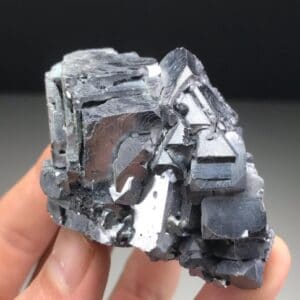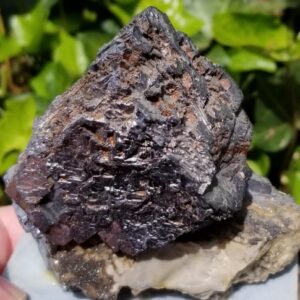Galena is relatively easy to identify because of its distinct silver color (metallic luster) and crystal structure. Freshly broken pieces will exhibit a perfect cleavage in three directions intersecting at 90 degrees.
If you have a specimen then you’ll need to understand that it will tarnish over time to a dull gray. Whatever you do, don’t try to polish off the tarnish.
Because Lead is a primary element in Galena, the mineral has a high specific gravity between 7.4 to 7.6, which is immediately noticed when picking it up. Galena is a soft mineral with a 2.5 on the Mohs hardness scale, producing a gray-to-black streak. Crystals are relatively common and are usually formed in cubes or octahedrons and don’t be surprised if you see them stacked on top of each other.

What Is Galena?
Galena is a Lead Sulfide. It’s the world’s primary Ore of Lead, and it’s mined from many deposits in many countries. Galena can be found in metamorphic and igneous rocks in medium-to-low temperature hydrothermal veins. In sedimentary rocks, Galena occurs as veins, isolated grains, Breccia cement, and as replacements of Dolostone and Limestone.
Is Galena Toxic?
While Galena is a beautiful mineral, and it might seem like something to wear in a piece of jewelry or display, Galena is toxic! Galena has a high Lead content, which makes it toxic, so it must be handled with care.
Galena is toxic to ingest and handle. However, the mineral can be handled safely if no lead dust is present. Mineral collectors with small samples should be okay, especially if the specimen is stored in a case. Unless you’re working around large amounts of dust on a regular basis, there is not much need to worry about the inorganic lead compounds. While Lead can’t be absorbed through our skin, this mineral should never be used as jewelry, where it can shatter into small crystal fragments through bumping or slight pressure. The threat with inorganic compounds is chronic toxicity from repeat or prolonged exposures by inhalation or ingestion that can eventually build up in the body’s system.
When in the field collecting, it can be easy to forget how deadly handling beautiful specimens can be. Even though most samples won’t cause death as quickly as something like venomous snakes and poisonous spiders, they can eventually result in illness or death over time. That said, it’s best to educate oneself on the minerals and gems they’re working with, as well as learn how to correctly identify the specimens you’re handling.
How Is Galena Formed?
Galena is formed in a wide range of hydrothermal environments. It can be found with Chalcopyrite and Sphalerite in massive Sulfide deposits that are associated with meta-volcanic rocks, like the Crandon deposit near Rhinelander. Galena is a component of some Granites and Pegamites that have been reported in the Wausau region.
It is incredibly abundant in the low-temperature hydrothermal deposits, widely known as the Mississippi Valley-type deposits that are commonly found in the southwestern portion of the state.

Galena Mineral Price
The current price of Galena or Lead Ore is about $5 per $9 ounce but most rock and mineral collectors are not purchasing raw materials. So, let’s talk about the price of Galena specimens which range between $5 to $10 depending on the size, condition, and quality. Larger crystals on matrix with no defects can demand much higher prices.
What Is Galena Used For?
Galena is an essential mineral because it serves as an ore from most of the lead production worldwide. It’s also a significant ore of Silver. It has very few uses beyond its commercial uses but crazy rocks hounds love digging for and collecting it.
The number one use of Lead is in the lead-acid batteries used for automobiles. Typical vehicle batteries contain about 20 pounds of Lead and must be replaced every four to five years. That said, there are billions of lead-acid batteries in the U.S. alone.
Lead-acid batteries are also used as standby power supplies for communication facilities, computer networks, and other critical systems.

Fun Facts About Galena Mineral
Galena’s perfect cubic cleavage, lead-gray color, metallic luster, and relative softness readily distinguish the mineral from most other metallic minerals. One of the most distinctive features is that it has a very high density and specific gravity.
- Galena is Latin for Lead Sulfide
- 1845 was the peak year of the mining district, with Galena as its hub, producing almost 85% of the nation’s Lead.
- The Lead Rush might not be as famous as the California Gold Rush, but it preceded the Gold Rush by 20 years.
- Ulysses S. Grant was the most famous citizen of Galena, Illinois (the town was named after the mineral). He moved to the town in 1860, a year before the Civil War began.
While Galena, Illinois, is one of the most famous areas, many others are named after the mineral as well.
- Identify Enstatite - March 12, 2024
- Identify Cerussite - March 3, 2024
- Identify Bytownite - February 18, 2024
